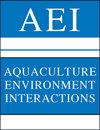Elevated temperatures increase growth and enhance foraging performances of a marine gastropod
IF 2.5
2区 农林科学
Q2 FISHERIES
引用次数: 2
Abstract
The oceans continue to warm due to rising atmospheric greenhouse gas concentrations. Most climate-change studies of aquaculture species use temperature changes based on coarseresolution climate models and without considering thermal ranges of an animal. Coarse-resolution climate models are generated by global-scale data, which is insufficient to capture the conditions of coastal areas where most aquaculture activity occurs. Therefore, ocean warming research on coastal organisms requires a more comprehensive design to include broad temperature gradients. By using the ecologically and commercially important coastal whelk Rapana venosa, we combined long-term and short-term experiments and selected 4 temperature treatments (19, 23, 27, and 30°C) to simulate different scenarios to test ocean warming effects on growth rates and foraging performances of whelks. We found that elevated temperature within the whelk’s thermal range (23 and 27°C) significantly increased growth rates and enhanced foraging performances of marine whelks when compared to the current temperature (19°C). Conversely, the whelk’s performance collapsed at 30°C in terms of both growth and foraging behavior. Our research clearly shows that local conditions and the tolerance range of a species must be considered to develop meaningful information for testing the effects of a changing climate. Our study suggests that rapa whelks may increase their feeding and reach larger sizes during warmer periods. Moreover, our study may provide a foundation for future climate research on aquaculture species.升高的温度促进了海洋腹足动物的生长和觅食性能
由于大气中温室气体浓度的上升,海洋继续变暖。大多数关于水产养殖物种的气候变化研究使用基于粗分辨率气候模型的温度变化,而没有考虑动物的温度范围。粗分辨率气候模型是由全球尺度数据生成的,这不足以捕捉大多数水产养殖活动发生的沿海地区的情况。因此,对沿海生物的海洋变暖研究需要更全面的设计,以包括广泛的温度梯度。以具有重要生态价值和商业价值的海岸海螺(Rapana venosa)为研究对象,选取19、23、27和30°C 4种温度处理,采用长期与短期相结合的实验方法,模拟不同温度条件下海洋变暖对海螺生长速率和觅食性能的影响。我们发现,与当前温度(19°C)相比,在海螺的温度范围内(23°C和27°C)升高的温度显著提高了海螺的生长速度和觅食性能。相反,在30°C时,海螺的生长和觅食行为都崩溃了。我们的研究清楚地表明,必须考虑当地条件和物种的耐受范围,才能为测试气候变化的影响提供有意义的信息。我们的研究表明,在温暖的时期,rapa海螺可能会增加它们的摄取量,并变得更大。此外,本研究可为今后水产养殖物种的气候研究提供基础。
本文章由计算机程序翻译,如有差异,请以英文原文为准。
求助全文
约1分钟内获得全文
求助全文
来源期刊

Aquaculture Environment Interactions
FISHERIES-MARINE & FRESHWATER BIOLOGY
CiteScore
4.90
自引率
13.60%
发文量
15
审稿时长
>12 weeks
期刊介绍:
AEI presents rigorously refereed and carefully selected Research Articles, Reviews and Notes, as well as Comments/Reply Comments (for details see MEPS 228:1), Theme Sections and Opinion Pieces. For details consult the Guidelines for Authors. Papers may be concerned with interactions between aquaculture and the environment from local to ecosystem scales, at all levels of organisation and investigation. Areas covered include:
-Pollution and nutrient inputs; bio-accumulation and impacts of chemical compounds used in aquaculture.
-Effects on benthic and pelagic assemblages or processes that are related to aquaculture activities.
-Interactions of wild fauna (invertebrates, fishes, birds, mammals) with aquaculture activities; genetic impacts on wild populations.
-Parasite and pathogen interactions between farmed and wild stocks.
-Comparisons of the environmental effects of traditional and organic aquaculture.
-Introductions of alien species; escape and intentional releases (seeding) of cultured organisms into the wild.
-Effects of capture-based aquaculture (ranching).
-Interactions of aquaculture installations with biofouling organisms and consequences of biofouling control measures.
-Integrated multi-trophic aquaculture; comparisons of re-circulation and ‘open’ systems.
-Effects of climate change and environmental variability on aquaculture activities.
-Modelling of aquaculture–environment interactions; assessment of carrying capacity.
-Interactions between aquaculture and other industries (e.g. tourism, fisheries, transport).
-Policy and practice of aquaculture regulation directed towards environmental management; site selection, spatial planning, Integrated Coastal Zone Management, and eco-ethics.
 求助内容:
求助内容: 应助结果提醒方式:
应助结果提醒方式:


